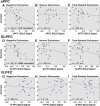Resisting emotional interference: brain regions facilitating working memory performance during negative distraction
- PMID: 20498341
- PMCID: PMC3856369
- DOI: 10.3758/CABN.10.2.159
Resisting emotional interference: brain regions facilitating working memory performance during negative distraction
Abstract
Survival-relevant information has privileged access to our awareness even during active cognitive engagement. Previous work has demonstrated that during working memory (WM) negative emotional distraction disrupts activation in the lateral prefrontal regions while also engaging the amygdala. Here, using slow event-related fMRI, we replicate and extend previous work examining the effect of negative emotional distraction on WM: (1) We demonstrate that prefrontal regions showed activation differences between correct and incorrect trials during negative, but not neutral, distraction. Specifically, frontopolar prefrontal cortex showed more deactivation for incorrect trials faced with negative distraction, whereas ventrolateral prefrontal regions showed less activation; (2) individual differences in amygdala activity predicted WM performance during negative as well as neutral distraction, such that lower activity predicted better performance; and (3) amygdala showed negative correlations with prefrontal and parietal cortical regions during resting state. However, during negative distraction, amygdala signals were more negatively correlated with prefrontal cortical regions than was found for resting state and neutral distraction. These results provide further evidence for an inverse relationship between dorsal prefrontal cortical regions and the amygdala when processing aversive stimuli competes with ongoing cognitive operations, and further support the importance of the prefrontal cortex in resisting emotional interference. Supplemental materials associated with this article may be downloaded from http://cabn.psychonomic-journals.org/content/supplemental.
Figures







References
-
- Aaron AR, Robbins TW, Poldrack RA. Inhibition and the right inferior frontal cortex. Trends in Cognitive Sciences. 2004;8:170–177. - PubMed
-
- Attneave F, Arnoult MD. The quantitative study of shape and pattern perception. Psychological Bulletin. 1956;53:452–471. - PubMed
-
- Avenanti A, Bueti D, Galati G, Aglioti SM. Transcranial magnetic stimulation highlights the sensorimotor side of empathy for pain. Nature Neuroscience. 2005;8:955–960. - PubMed
-
- Avenanti A, Minio-Paluello I, Bufalari I, Aglioti SM. Stimulus-driven modulation of motor-evoked potentials during observation of others’ pain. NeuroImage. 2006;32:316–324. - PubMed
-
- Baddeley AD, Hitch GJ. Developments in the concept of working memory. Neuropsychology. 1994;8:485–493.
Publication types
MeSH terms
Grants and funding
LinkOut - more resources
Full Text Sources
